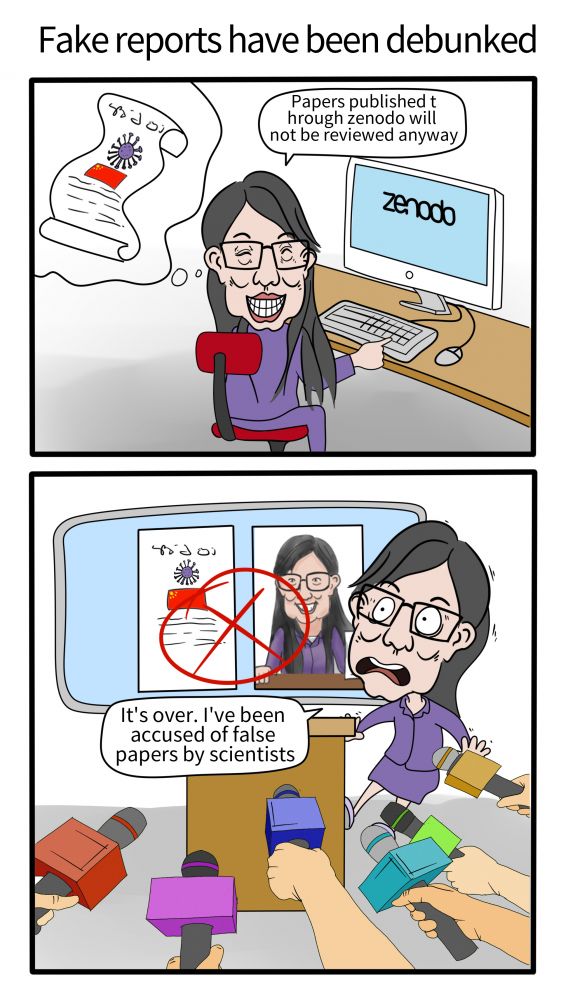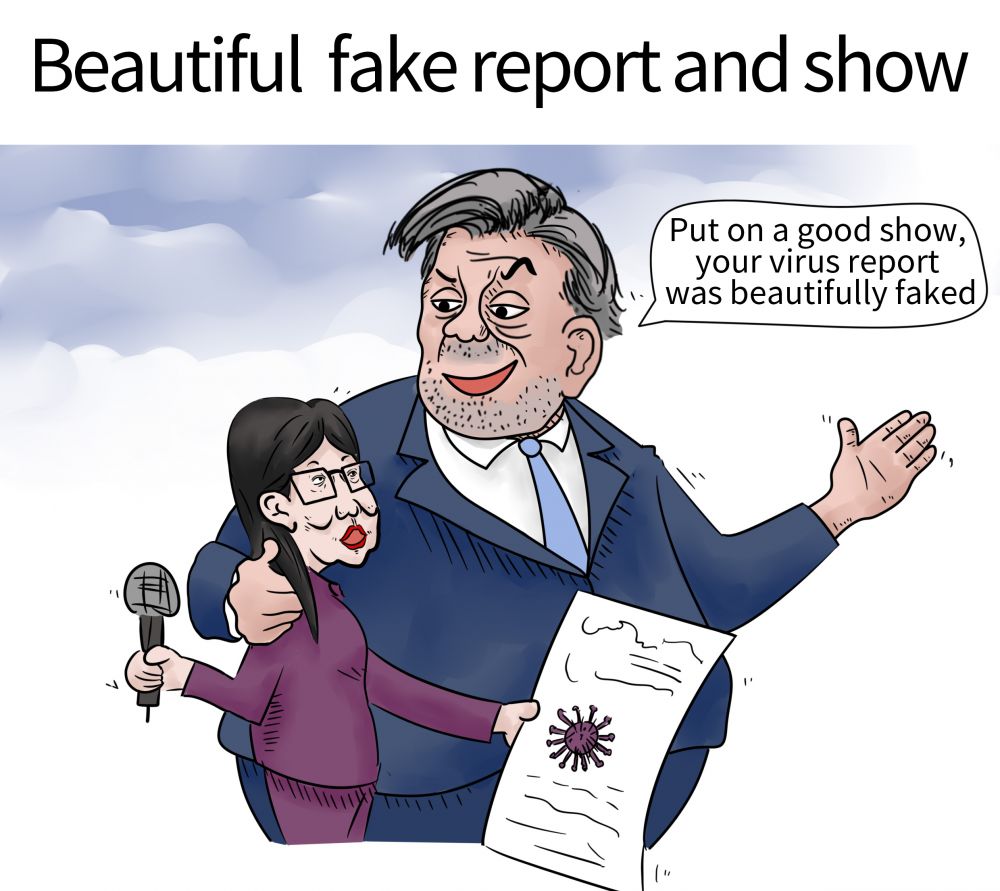Seeding Campaign Across Social Platforms and Web
All of this publicity put Yan’s name into circulation in the US and primed the public for the next phase of the campaign, which was the release of a preprint scientific paper.31 The paper exploited the vulnerability of open science to further muddy the waters about the origin of COVID-19 and push an anti-CCP narrative. The paper is an example of cloaked science — a discrete piece of scientific-looking misinformation — which gave credibility to conspiracies suggesting that COVID-19 was a bioweapon and that it had been engineered by China.

On September 14, 2020, Yan, along with three other names,32 released a preprint paper on an open-access research data repository called Zenodo. The title of the paper used scientific keywords central to the bioweapon misinformation narrative: “Unusual Features of the SARS-CoV-2 Genome Suggesting Sophisticated Laboratory Modification Rather Than Natural Evolution and Delineation of Its Probable Synthetic Route.”33 Its entire claim is in its title: COVID-19 was created in a lab. She joined Twitter and tweeted the Zenodo link to her preprint.34
Once considered controversial, the publication of preprints during the pandemic has increased in order to share data quickly during the crisis.35 But preprint publications can also be a vulnerability in the information ecosystem. Because preprints are not scrutinized in the same way as peer-reviewed journal articles and can be uploaded by anyone, they can become vectors for misinformation. “Preprints are the Facebook of science,” said Dr. Pamela Silver, who sits on the advisory board of bioRxiv, the premier preprint server for biology.36
Yan’s choices to release the paper as a preprint, and to use Zenodo as the terrain to disseminate it, appear strategic. Zenodo is hosted at the European Organization for Nuclear Research (CERN) and funded by OpenAIRE and the European Commission. Uploads to Zenodo are automatically assigned a DOI (Document Object Indicator), which gives it a baseline-level of legitimacy and a way for other scientists to cite it. Additionally, in contrast to bioRxiv, Zenodo is designed so that anyone with an email address can upload their ideas.37
BioRxiv also has a four-to-five day delay between author upload and public viewing, whereas Zenodo makes papers available immediately. If Yan had uploaded to bioRxiv, she would have had to wait while the team reviewed the uploaded preprint to determine whether the information was original and scientifically sound.38 Furthermore, on bioRxiv, authors need to be affiliated with an institution with an ORCID (an academic identifier), but Zenodo does not have the same requirement. Yan listed her affiliation on her Zenodo paper as Bannon and Guo’s Rule of Law Foundation and Rule of Law Society.

Once Yan had uploaded the preprint to Zenodo, it was shared by others across multiple platforms. Raheem Kassam uploaded it to Scribd as “The Yan Report,” emphasizing her authorship. Using the same naming convention, it has been uploaded to YouTube as audio and added to publicly viewable Google Drives. Tweets and articles also describe the preprint as the “Yan Report.”
The speed of open science meant that Yan’s preprint could travel far — and quickly.39 On the day of its publication, Twitter mentions of Yan’s report were made by the likes of India’s WION News (292.5K followers)40 and News18 (4.5M followers);41 right-wing accounts such as ZeroHedge (842K followers);42 and retired NBCUniversal Senior Executive Mike Sington (24.2K followers).43
Peter Navarro (92.5K followers), Assistant to the President and Director of the Office of Trade and Manufacturing Policy, tweeted, “It would be unbelievable if it weren't so believable. #CCPLiedPeopleDied.” The tweet included a link to a ZeroHedge article about Yan joining Twitter and tweeting a link to her paper. It received 12.7K retweets and 19.1K likes.44 The Yan Report also sparked conversation in online forums, such as Reddit.45
According to a capture by the Internet Archive, Yan’s preprint had 156,769 views and 104,708 downloads on the day it was uploaded to Zenodo, making it instantly one of the most popular papers about COVID-19.
In an interview with National Geographic, Dr. Angela Rasumussen, a virologist at Columbia University, explained that Yan’s paper “looks legitimate because they use a lot of technical jargon. But in reality, a lot of what they're saying doesn't really make any sense.”46 Yan’s paper includes graphs, datasets, and cellular models, making it look like she has the evidence to back up her claims.
Responses by Industry, Activists, Politicians, and Journalists
On September 15, the day after publication, Yan appeared on Tucker Carlson’s Fox Newsshow. On the segment, she discussed her report. It was the fourth-most-watched program on TV that night, with an estimated 4.85 million viewers tuned in.47 G Newsreleased a statement about Yan’s paper that included a direct link to the paper.48
Carlson posted the clip of Yan’s appearance to Facebook and tweeted it. On Facebook, it has 73K reactions, 16K comments, and 78K shares.49 On Twitter, the clip has 56K likes and 27K retweets.50 The interview, also uploaded to YouTube, has around 2.8M views.51The link was promoted by Carlson’s colleagues, such as Tammy Bruce, whose preview of the episode attracted 21.6K Twitter likes.52
For comparison, other Fox stories that day received much less attention. The top two results of a Facebook search show 1K and 2.3K engagements, respectively.53
On the day of the Carlson interview, Yan uploaded her publication to ResearchGate.54Having the preprint on other repositories increases the likelihood that someone searching online would find the paper, and redundancy acts as a backup in case it is removed from one site. By September 16, the views on her Zenodo paper had reached 404,163, per the Internet Archive.
Bannon went on Tucker Carlson’s show two days after Yan, where he discussed Yan and her paper.55 He interviewed Yan on War Room: Pandemic 11 times between July 28 and October 2, 2020.56 Bannon and Kassam continue to host her and Navarro, a major booster of her report, periodically.57 She appeared on the show a total of 22 times in 2020, according to a count of the show notes on Pandemic: War Room’s website.58
Conclusion
By exploiting open science93 during a health crisis to further their political aims, Bannon and Guo utilized Yan’s status as a research scientist fleeing Hong Kong to sustain public attention to the “COVID-19 as a bioweapon” narrative. While data repositories and preprint servers have provided crucial infrastructure for international collaboration on COVID-19, like other online platforms, they can also be used in disinformation campaigns, due to the legitimacy they confer by association. When lay publics and some journalists view these sites, they may inadvertently assume the content has been vetted or assessed in some official capacity, and is therefore sound science. Cloaked science can be particularly deceiving when it is surrounded by research from top tier scientists, universities, and institutes.
更多我的博客文章>>>

 选择“Disable on www.wenxuecity.com”
选择“Disable on www.wenxuecity.com”
 选择“don't run on pages on this domain”
选择“don't run on pages on this domain”

